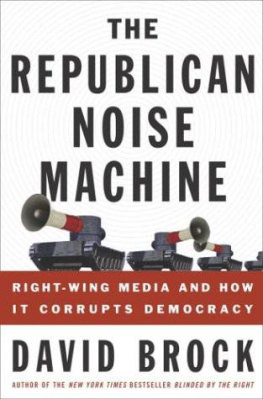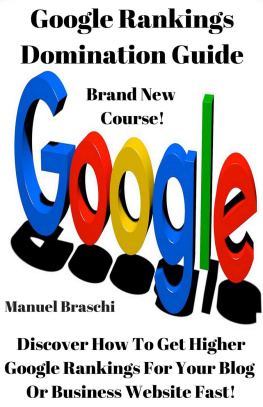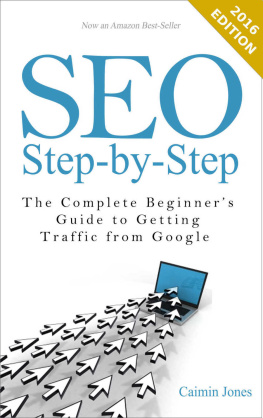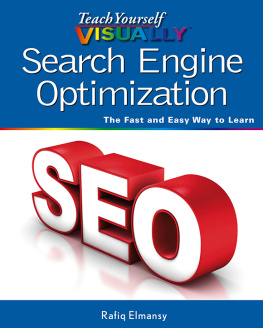Also by David Brock
Affiliate Marketing Action Plan
Affiliate Marketing Excellence
Alternative Fuel Secrets
Amazing Images
Bing To Win
The New Guide to SEO
The New Guide to SEO
By David Brock
*****
The Most Up-to-Date Advice and Strategies Including Real -Time SEO, Voice Search, Content Marketing and More
Table Of Contents
How SEO Works
Enter Black-Hat SEO
The Death of SEO?
Examples of Modern Approaches to SEO
How to Make Excellent Content
Introducing a Conversational Google
Schemas and Structured Data
Design and Layout
More On-Page Optimization
Trust
Google News and Other Important Sites
Working with Influencers
Link Bait and Creating Organic Links
Backlink Research
What is Content Marketing?
How to Build Trust and Authority
Campaign
The Trouble with SEO Companies
Using Metrics, Tracking Tools and Google Analytics
Using Analytics in Your Own Campaign
Real Time SEO
Voice Search and AI Assistants
KGO: Optimizing for Googles Quick Answers
Chapter 1: An Introduction to SEO Still Kicking
I f you want to get the maximum amount of profit from a website, then you need to get as much traffic as you can. If you want to get the maximum amount of traffic to your website, then you need to get to the top of Google.
And if you want to get to the top of Google, then you need SEO or Search Engine Optimization. Search
Engine Optimization is the process of optimizing a website so that Google will be more likely to index it and ensure that it ranks highly for the most relevant key words and phrases. For example, if you have a website the sells hats, then you might try to get it to rank for the phrase buy hats online. To do this, you would go through an optimization process that would involve both on site and off site strategies.
With any luck, you would eventually be able to get your website to the top of the SERP for that term (Search Engine Results Page) and thereby attract a huge amount of traffic. More importantly, that traffic would not just be from random visitors but would rather be from specific people who are looking for hats. Better yet, those people will be looking for hats at the very point that they came to your website (why else would they search for hats?) which thereby means that theyre ready to buy and it should only take a small push to get them to make that decision.
SEO can be a slow going process but it is still possible to very reliably climb the ranks and to get your website to a point where it will start getting more and more organic traffic from searches.
How SEO Works
SEO essentially works by attempting to second guess the algorithms used by Google to decide which sites to index and where to rank them. Google works by using bots, an index and an algorithm. The bots, also known as robots or spiders, are small pieces of code designed to head out onto the web and look for content. They read webpages and they add that content to a massive index, that Google can use as a reference.
From there, Google will then use an algorithm to identify which content in that index is relevant to which search and which is offering value to the end user. Ultimately, the aim of Google is to help people find interesting content that will be relevant to what theyre looking for.
This involves a lot of factors and the algorithm will look at how many links the content has, how visitors behave on that website and the use of key phrases within the content. If a word or phrase is repeated often enough, then it is possible to deduce that said word or phrase is likely to be the subject matter and thus it should come up in searches for matching terms.
SEO basically works by predicting and guessing how the algorithm works (because no one can be completely sure) and then using that information in order to engineer your website to get the maximum number of hits. It means gaming the system and this in turn can allow you to trick Google into believing that your site should be number one.
Of course its not quite that simple though and actually, as we dig deeper, well see that there are other ways of looking at SEO that are more efficient. Apart from anything else, Google is constantly updating its algorithms (usually with words beginning with P like Penguin, Panda and Pigeon) and that means that second guessing Google can get you into trouble.
Being effective at SEO means having an up-to-date understanding of how it works and it means knowing the core principles that underlie the different strategies. Thats where this book comes in. Read on and youll learn which old, outdated strategies you need to avoid, how to work with Google to get the very best results and how to future-proof your site for upcoming changes.
This is the modern guide to SEO for modern marketers and site owners. This is your SEO bible and your key to unlocking incredible success on the web!
Chapter 2: SEO What it Used to Mean
Were going to start this book with a little history lesson.
Why? Because understanding how SEO used to work, how it has progressed and what you now need to avoid is a very good way of creating context and helping you to understand what SEO means today.
When SEO was first born, Googles algorithm was a lot simpler and manipulating it to your own ends was a lot easier as a result. Back then, Google looked at two key factors in determining its rankings. Those factors were:
Keyword density
Links profile
Your links profile (also called backlinks profile) is essentially determined by how many links you have pointing at your website, coming from other sites. This serves two important roles. Firstly, links help Googles robots to find your website. Bots crawl the web by reading content and following links from one site to another. If you have a link on a site that Google has already indexed, then this will allow it to find yours and add it to the network.
At the same time, Google views links as testimony assuming that a website would only link to another website if it though that said website was good and had something valuable to offer its users. Google would also assume that if you have links from 20 websites about hats, then your site is probably going to be about hats as well (especially if the anchor text has your search phrase in it).
The other factor was keyword density. Keyword density meant how many times your website would repeat the words that you were trying to rank for. The more content you had and the more often you repeated the same phrase throughout that content, the more likely you would ultimately be to get ranked for that search term and to show up high in the SERPs.
Of course it was also important to research the keywords and to make sure that they were actually being searched for. For this, marketers could use Googles keyword research tool in order to check the volume of searches and to get an idea of how much competition was there. A savvy optimizer would be able to then look at the terms that had the highest search volumes and lowest amount of competition and then try to rank for those phrases specifically.


















